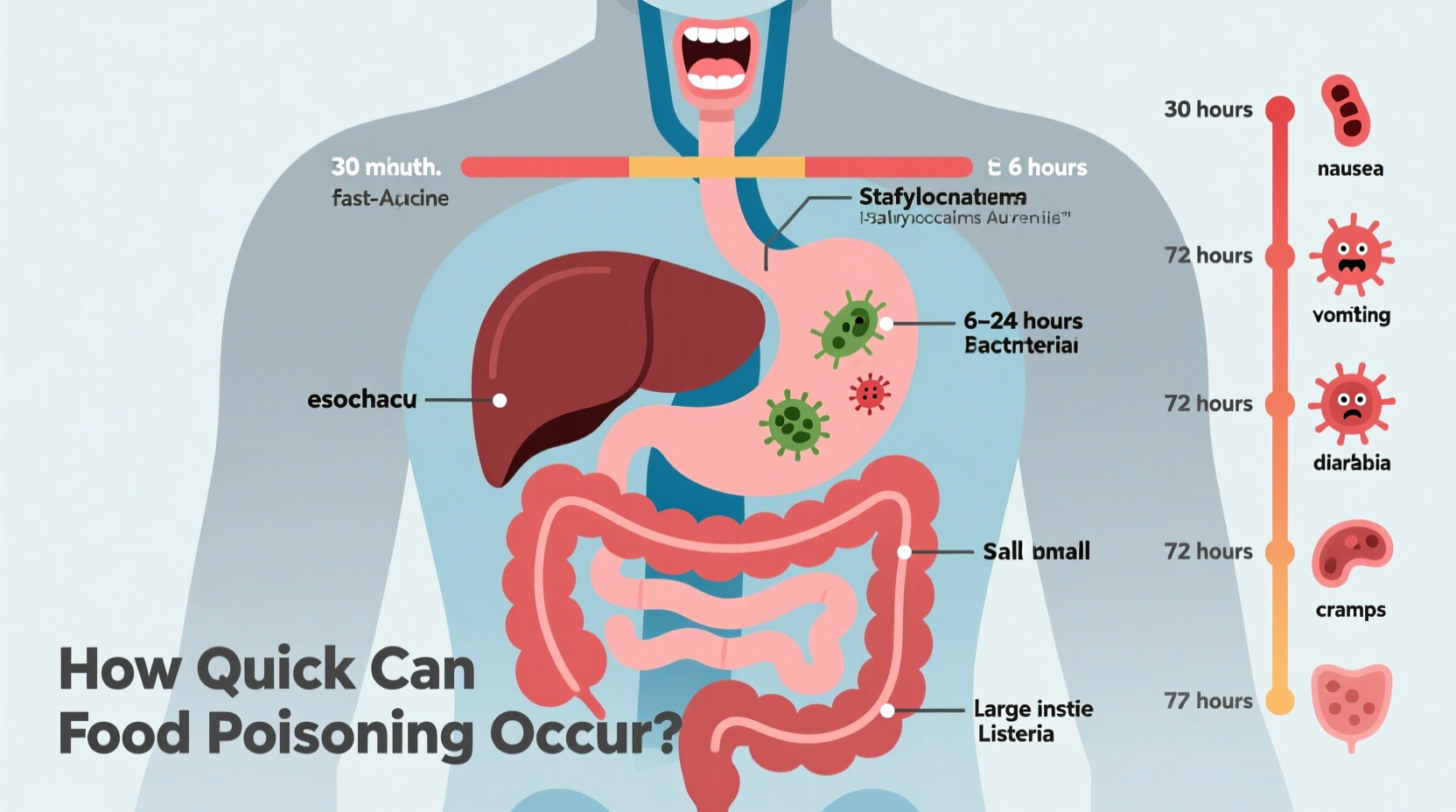Understanding Food Poisoning Onset Times
When you're suddenly hit with nausea, vomiting, or diarrhea after eating, your first question is likely: How quickly can food poisoning occur? The answer varies significantly based on the contaminant. While some pathogens trigger symptoms within minutes, others may take days to manifest.
Pathogen-Specific Onset Timeframes
Understanding which foodborne illness you might be facing starts with recognizing the timeline. Different bacteria, viruses, and toxins have characteristic incubation periods that serve as important diagnostic clues.
| Pathogen | Typical Onset Time | Common Sources | Duration |
|---|---|---|---|
| Staphylococcus aureus | 30 minutes - 8 hours | Handled foods, salads, cream-filled pastries | 1-2 days |
| Bacillus cereus (emetic) | 1-6 hours | Fried rice, pasta, spices | 6-24 hours |
| Salmonella | 6 hours - 6 days | Raw eggs, poultry, dairy | 4-7 days |
| E. coli (STEC) | 1-10 days (avg 3-4) | Undercooked beef, raw milk, leafy greens | 5-10 days |
| Norovirus | 12-48 hours | Contaminated water, shellfish, ready-to-eat foods | 1-3 days |
| Listeria | 1-4 weeks (up to 70 days) | Delicatessen meats, soft cheeses, unpasteurized milk | Variable |
This comprehensive data from the CDC shows the significant variation in food poisoning incubation periods. The Centers for Disease Control and Prevention tracks these patterns to help identify outbreak sources and educate the public about food safety risks.
Factors Influencing How Quickly Food Poisoning Strikes
Several variables affect how rapidly symptoms develop after consuming contaminated food:
Pathogen Type and Quantity
The specific microorganism and the amount ingested directly impact onset time. For instance, Staphylococcus aureus produces pre-formed toxins that cause almost immediate symptoms, while Listeria requires time to multiply in your system before making you ill.
Individual Health Factors
Your immune status significantly affects symptom timing. According to the FDA's Foodborne Illness Risk Communication, children, elderly individuals, and those with compromised immune systems often experience faster onset and more severe symptoms.
Food Matrix Effects
The type of food consumed matters. Fatty foods can delay gastric emptying, potentially slowing toxin absorption, while liquid vehicles like juices may accelerate symptom development. The World Health Organization notes that food composition affects how pathogens interact with your digestive system.
Symptom Progression Timeline
Understanding the typical progression helps distinguish food poisoning from other gastrointestinal issues:
- Initial exposure - Consuming contaminated food or beverage
- Incubation period - Time before symptoms appear (varies by pathogen)
- Prodromal phase - Early symptoms like mild nausea or abdominal discomfort
- Acute phase - Peak symptoms including vomiting, diarrhea, fever
- Recovery phase - Gradual improvement as body eliminates pathogen
This progression timeline from the CDC Foodborne Outbreaks documentation helps healthcare providers diagnose the likely cause based on symptom patterns.
When to Seek Medical Attention Immediately
Certain symptoms require urgent medical care regardless of onset time:
- Signs of severe dehydration (dry mouth, little urination, dizziness)
- Blood in vomit or stool
- High fever (over 101.5°F or 38.6°C)
- Symptoms lasting more than 3 days
- Numbness, muscle weakness, or vision problems (possible botulism)
The FDA Food Safety guidelines emphasize that rapid symptom onset with neurological symptoms requires immediate emergency care, as this could indicate botulism or other severe conditions.
Preventing Rapid-Onset Food Poisoning
Understanding how quickly food poisoning can occur highlights the importance of prevention:
Temperature Danger Zone Awareness
Maintain food temperatures properly—keep cold foods below 40°F (4°C) and hot foods above 140°F (60°C). Bacteria multiply rapidly between these temperatures, potentially reaching dangerous levels in just 2 hours (1 hour if ambient temperature exceeds 90°F).
Hand Hygiene Practices
Wash hands thoroughly before handling food and after using the restroom. This simple practice prevents transmission of pathogens like Staphylococcus aureus that cause rapid-onset illness.
Proper Food Storage
Refrigerate leftovers within 2 hours of cooking (1 hour if temperatures exceed 90°F). The CDC's food storage recommendations help prevent bacterial growth that leads to food poisoning.

Recovering from Food Poisoning
If you experience rapid-onset food poisoning symptoms:
- Stay hydrated with clear fluids or oral rehydration solutions
- Avoid anti-diarrheal medications for bacterial infections (they can prolong illness)
- Rest and allow your digestive system to recover
- Gradually reintroduce bland foods like toast, rice, and bananas
The WHO Food Safety guidelines recommend against self-medicating with antibiotics unless prescribed by a healthcare provider, as this can worsen certain types of foodborne illness.
Common Questions About Food Poisoning Onset
Understanding the timing of food poisoning symptoms helps identify potential sources and determine appropriate responses.











 浙公网安备
33010002000092号
浙公网安备
33010002000092号 浙B2-20120091-4
浙B2-20120091-4